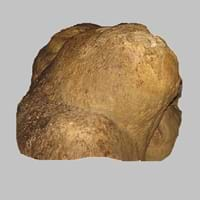Definition
Travertine is a mineral consisting of layered calcium carbonate formed by deposition from spring waters
Breccia is a rock consisting of angular fragments of stones which are cemented by finer calcareous material
Discoverer
Marcus Vitruvius Pollio
Unknown
Etymology
From Italian travertino a kind of building stone, from Tiburs, adjective from Tibur (Tivoli), in Italy
From Italian, literally gravel, Germanic origin and related to break
Class
Sedimentary Rocks
Sedimentary Rocks
Sub-Class
Durable Rock, Medium Hardness Rock
Durable Rock, Hard Rock
Group
Not Applicable
Not Applicable
Other Categories
Fine Grained Rock, Opaque Rock
Coarse Grained Rock, Medium Grained Rock, Opaque Rock
Texture
Banded
Brecciated, Clastic
Color
Beige, Black, Blue, Brown, Grey, Red, White, Yellow
Beige, Black, Blue, Brown, Buff, Green, Grey, Orange, Pink, Purple, Red, Rust, White, Yellow
Durability
Durable
Durable
Scratch Resistant
Yes
Yes
Appearance
Fibrous
Layered, Banded, Veined and Shiny
Interior Uses
Decorative Aggregates, Entryways, Flooring, Homes, Interior Decoration
Countertops, Decorative Aggregates, Entryways, Floor Tiles, Flooring, Homes, Hotels, Interior Decoration
Exterior Uses
As Building Stone, As Facing Stone, Paving Stone, Garden Decoration, Office Buildings
As Building Stone, As Facing Stone, Paving Stone, Garden Decoration, Office Buildings
Other Architectural Uses
Curbing
Curbing
Construction Industry
As Dimension Stone, Building houses or walls, Cement Manufacture, Construction Aggregate, for Road Aggregate, Raw material for the manufacture of mortar
As Dimension Stone, Construction Aggregate, Landscaping, Roadstone
Medical Industry
Not Yet Used
Not Yet Used
Antiquity Uses
Artifacts, Jewellery, Monuments, Sculpture, Small Figurines
Artifacts, Sculpture
Commercial Uses
Cemetery Markers, Creating Artwork, Gemstone, Jewelry, Paper Industry, Pottery
Creating Artwork, Gemstone, Jewelry
Types
Not Available
Collapse Breccia, Fault Breccia, Flow Breccia, Pyroclastic Breccia, Igneous Breccia and Impact Breccia
Features
Stalactites and stalagmites are formed from this rock, Surfaces are often shiny, Very fine grained rock
Available in Lots of Colors and Patterns, Clasts are smooth to touch
Archaeological Significance
Monuments
Used
Not Yet Used
Famous Monuments
Colosseum in Rome, Italy, Sacré Coeur in Paris, France, Trevi Fountain in Rome, Italy
Not Applicable
Famous Sculptures
Data Not Available
Data Not Available
Pictographs
Used
Not Used
Petroglyphs
Used
Not Used
Formation
Travertine is a type of sedimentary rock formed when a river carries or transports pieces of broken rock which then undergo sedimentation. They are then subjected to high temperature and pressure hence forming travertine rock.
Breccia is a clastic sedimentary rock which is composed of broken fragments of minerals or rock which are cemented together by a fine-grained matrix and it forms where broken, angular fragments of rock or mineral debris accumulate.
Mineral Content
Calcite, Clay, Feldspar, Micas, Quartz
Calcite, Clay, Feldspar, Phosphates, Quartz, Silica
Compound Content
Ca, NaCl, CaO, Oxygen
Aluminium Oxide, Ca, NaCl, CaO, Iron(III) Oxide, Potassium Oxide, Sodium Oxide, Silicon Dioxide, Titanium Dioxide
Types of Metamorphism
Not Applicable
Burial Metamorphism, Cataclastic Metamorphism
Types of Weathering
Biological Weathering, Chemical Weathering, Mechanical Weathering
Biological Weathering, Chemical Weathering, Mechanical Weathering
Types of Erosion
Chemical Erosion, Coastal Erosion, Glacier Erosion
Chemical Erosion
Grain Size
Fine Grained
Medium to Coarse Grained
Fracture
Splintery
Uneven
Porosity
Highly Porous
Less Porous
Luster
Dull to Pearly
Dull to Pearly
Compressive Strength
Not Available
Cleavage
Non-Existent
Non-Existent
Toughness
1
Not Available
Specific Gravity
1.68
2.86-2.87
Transparency
Opaque
Opaque
Density
2.71 g/cm3
0 g/cm3
Specific Heat Capacity
Not Available
Resistance
Impact Resistant, Pressure Resistant, Wear Resistant
Heat Resistant, Impact Resistant, Pressure Resistant, Wear Resistant
Deposits in Eastern Continents
Asia
China, Russia
China, India, Kazakhstan, Mongolia, Russia, South Korea, Uzbekistan
Africa
Not Yet Found
Namibia, Nigeria, South Africa
Europe
Austria, Italy, Portugal, United Kingdom
Austria, Denmark, Germany, Great Britain, Netherlands, Norway, Poland, Sweden, Switzerland, United Kingdom
Others
Not Yet Found
Greenland
Deposits in Western Continents
North America
Canada, USA
Barbados, Canada, Mexico, Panama, USA
South America
Argentina, Bolivia, Ecuador
Brazil
Deposits in Oceania Continent
Australia
Not Yet Found
New South Wales, New Zealand
All about Travertine and Breccia Properties
Know all about Travertine and Breccia properties here. All properties of rocks are important as they define the type of rock and its application. Travertine and Breccia belong to Sedimentary Rocks.Texture of Travertine is Banded whereas that of Breccia is Brecciated, Clastic. Travertine appears Fibrous and Breccia appears Layered, Banded, Veined and Shiny. The luster of Travertine and Breccia is dull to pearly. Travertine is available in beige, black, blue, brown, grey, red, white, yellow colors whereas Breccia is available in beige, black, blue, brown, buff, green, grey, orange, pink, purple, red, rust, white, yellow colors. The commercial uses of Travertine and Breccia are cemetery markers, creating artwork, gemstone, jewelry, paper industry, pottery.










